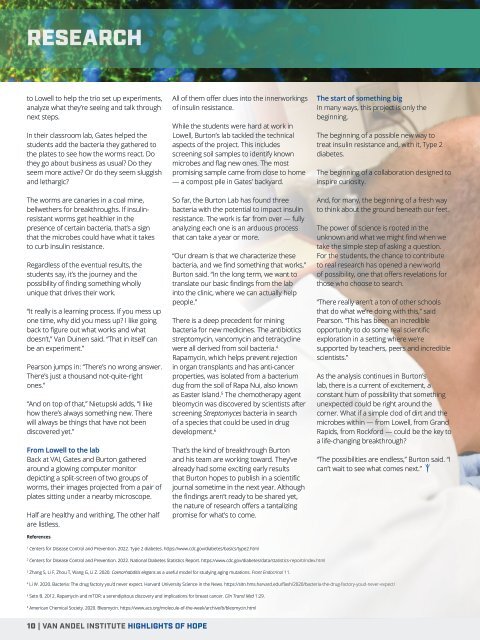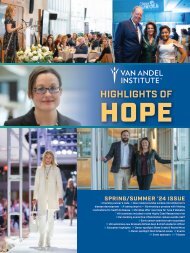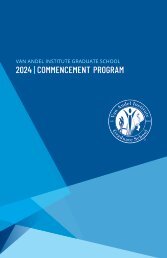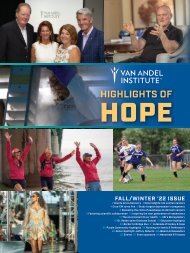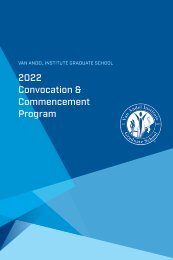2023 Fall/Winter Highlights of Hope
This is the 2023 Fall/Winter edition of Van Andel Institute's Highlights of Hope donor publication.
This is the 2023 Fall/Winter edition of Van Andel Institute's Highlights of Hope donor publication.
Create successful ePaper yourself
Turn your PDF publications into a flip-book with our unique Google optimized e-Paper software.
RESEARCH<br />
to Lowell to help the trio set up experiments,<br />
analyze what they’re seeing and talk through<br />
next steps.<br />
In their classroom lab, Gates helped the<br />
students add the bacteria they gathered to<br />
the plates to see how the worms react. Do<br />
they go about business as usual? Do they<br />
seem more active? Or do they seem sluggish<br />
and lethargic?<br />
The worms are canaries in a coal mine,<br />
bellwethers for breakthroughs. If insulinresistant<br />
worms get healthier in the<br />
presence <strong>of</strong> certain bacteria, that’s a sign<br />
that the microbes could have what it takes<br />
to curb insulin resistance.<br />
Regardless <strong>of</strong> the eventual results, the<br />
students say, it’s the journey and the<br />
possibility <strong>of</strong> finding something wholly<br />
unique that drives their work.<br />
“It really is a learning process. If you mess up<br />
one time, why did you mess up? I like going<br />
back to figure out what works and what<br />
doesn’t,” Van Duinen said. “That in itself can<br />
be an experiment.”<br />
Pearson jumps in: “There’s no wrong answer.<br />
There’s just a thousand not-quite-right<br />
ones.”<br />
“And on top <strong>of</strong> that,” Nietupski adds, “I like<br />
how there’s always something new. There<br />
will always be things that have not been<br />
discovered yet.”<br />
From Lowell to the lab<br />
Back at VAI, Gates and Burton gathered<br />
around a glowing computer monitor<br />
depicting a split-screen <strong>of</strong> two groups <strong>of</strong><br />
worms, their images projected from a pair <strong>of</strong><br />
plates sitting under a nearby microscope.<br />
Half are healthy and writhing. The other half<br />
are listless.<br />
References<br />
All <strong>of</strong> them <strong>of</strong>fer clues into the innerworkings<br />
<strong>of</strong> insulin resistance.<br />
While the students were hard at work in<br />
Lowell, Burton’s lab tackled the technical<br />
aspects <strong>of</strong> the project. This includes<br />
screening soil samples to identify known<br />
microbes and flag new ones. The most<br />
promising sample came from close to home<br />
— a compost pile in Gates’ backyard.<br />
So far, the Burton Lab has found three<br />
bacteria with the potential to impact insulin<br />
resistance. The work is far from over — fully<br />
analyzing each one is an arduous process<br />
that can take a year or more.<br />
“Our dream is that we characterize these<br />
bacteria, and we find something that works,”<br />
Burton said. “In the long term, we want to<br />
translate our basic findings from the lab<br />
into the clinic, where we can actually help<br />
people.”<br />
There is a deep precedent for mining<br />
bacteria for new medicines. The antibiotics<br />
streptomycin, vancomycin and tetracycline<br />
were all derived from soil bacteria. 4<br />
Rapamycin, which helps prevent rejection<br />
in organ transplants and has anti-cancer<br />
properties, was isolated from a bacterium<br />
dug from the soil <strong>of</strong> Rapa Nui, also known<br />
as Easter Island. 5 The chemotherapy agent<br />
bleomycin was discovered by scientists after<br />
screening Streptomyces bacteria in search<br />
<strong>of</strong> a species that could be used in drug<br />
development. 6<br />
That’s the kind <strong>of</strong> breakthrough Burton<br />
and his team are working toward. They’ve<br />
already had some exciting early results<br />
that Burton hopes to publish in a scientific<br />
journal sometime in the next year. Although<br />
the findings aren’t ready to be shared yet,<br />
the nature <strong>of</strong> research <strong>of</strong>fers a tantalizing<br />
promise for what’s to come.<br />
The start <strong>of</strong> something big<br />
In many ways, this project is only the<br />
beginning.<br />
The beginning <strong>of</strong> a possible new way to<br />
treat insulin resistance and, with it, Type 2<br />
diabetes.<br />
The beginning <strong>of</strong> a collaboration designed to<br />
inspire curiosity.<br />
And, for many, the beginning <strong>of</strong> a fresh way<br />
to think about the ground beneath our feet.<br />
The power <strong>of</strong> science is rooted in the<br />
unknown and what we might find when we<br />
take the simple step <strong>of</strong> asking a question.<br />
For the students, the chance to contribute<br />
to real research has opened a new world<br />
<strong>of</strong> possibility, one that <strong>of</strong>fers revelations for<br />
those who choose to search.<br />
“There really aren’t a ton <strong>of</strong> other schools<br />
that do what we’re doing with this,” said<br />
Pearson. “This has been an incredible<br />
opportunity to do some real scientific<br />
exploration in a setting where we’re<br />
supported by teachers, peers and incredible<br />
scientists.”<br />
As the analysis continues in Burton’s<br />
lab, there is a current <strong>of</strong> excitement, a<br />
constant hum <strong>of</strong> possibility that something<br />
unexpected could be right around the<br />
corner. What if a simple clod <strong>of</strong> dirt and the<br />
microbes within — from Lowell, from Grand<br />
Rapids, from Rockford — could be the key to<br />
a life-changing breakthrough?<br />
“The possibilities are endless,” Burton said. “I<br />
can’t wait to see what comes next.”<br />
1<br />
Centers for Disease Control and Prevention. 2022. Type 2 diabetes. https://www.cdc.gov/diabetes/basics/type2.html<br />
2<br />
Centers for Disease Control and Prevention. 2022. National Diabetes Statistics Report. https://www.cdc.gov/diabetes/data/statistics-report/index.html<br />
3<br />
Zhang S, Li F, Zhou T, Wang G, Li Z. 2020. Caenorhabditis elegans as a useful model for studying aging mutations. Front Endocrinol 11.<br />
4<br />
Li W. 2020. Bacteria: The drug factory you’d never expect. Harvard University Science in the News. https://sitn.hms.harvard.edu/flash/2020/bacteria-the-drug-factory-youd-never-expect/<br />
5<br />
Seto B. 2012. Rapamycin and mTOR: a serendipitous discovery and implications for breast cancer. Clin Transl Med 1:29.<br />
6<br />
American Chemical Society. 2020. Bleomycin. https://www.acs.org/molecule-<strong>of</strong>-the-week/archive/b/bleomycin.html<br />
10 | VAN ANDEL INSTITUTE HIGHLIGHTS OF HOPE


